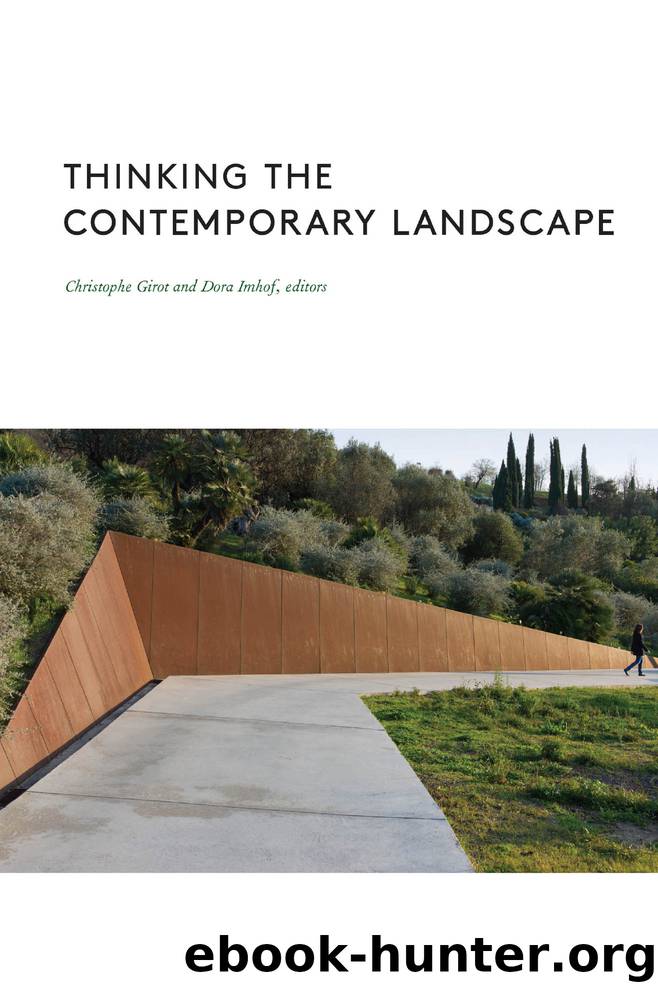Thinking the Contemporary Landscape by Christophe Girot

Author:Christophe Girot [Christophe Girot and Dora Imhof]
Language: eng
Format: epub
Publisher: Princeton Architectural Press
Published: 2017-03-14T04:00:00+00:00
THE LANDSCAPE AS BODY
Topology reaches far beyond the reading of a landscape in stratified layers, and moves rather toward a composite reading of terrain as a single body and surface, thus bringing disparate elements and epochs back together. A designer that comes to a place for the first time comes with a cultural baggage of his or her own and is often blinded by preestablished ideas and conventions. The limitations of a given culture in reading others is difficult to accept and probably the most humbling of things. Returning to Michel Corajoud’s conjecture there certainly exists a tangible cultural framing to our own reading and understanding of landscape. Being a complete foreigner to a land can sometimes be an advantage, but in most instances it isn’t, and there are serious doubts as to whether any landscape tradition is exportable from one country to the next, from one language to the other, from a particular region to the next without careful consideration and meditation. How can an archetype gradually transfer from one culture to the next by exerting a significant shift in trope? This is particularly remarkable between the early Ming gardens of China and the Zen gardens of Japan, as well as between the artificially wooded gardens of Renaissance Italy and the subsequent picturesque gardens of England. The fundamental shift in landscape spirit and expression in these two comparisons is clear, although the garden types remain roughly the same. Any invention in landscape architecture needs a starting point that is by definition local and not global. In addition to cultural differences there also exist shifts in topography, climate cycles, and modes of urbanization that seriously challenges assertions about a global approach to landscape architecture whether ecological or not.
A systems approach to site planning is indeed important in the early stages of project analysis, it helps identify conflicts of interest as well as resources and is a powerful tool that enables the formulation of precise environmental policies. The approach can embrace vast environmental questions at a regional scale and can nurture a project by identifying the potential services provided; but it cannot become a substitute to creative design by giving in to formulaic answers with regard to form giving. It is a fallacy to believe that we are now able to promote a global landscape culture capable of responding to ecological trends worldwide. Such formulas inevitably come short of many local needs and expectations. It reminds one of the stylistic transfers that occurred earlier on with the English Garden style in Australia, which proved to be completely wrong for an entire continent. The very idea of transposing some triumphant pastoral landscape onto the parched and overgrazed inland hills of the capital Canberra proved the inherent limitations of such a literal landscape import. Both the McHargian overlay method and topology would have decried the Griffin Plan for the Australian capital because it spoke against any climatic and biotic reality. But the lobby in favor of “autumn color and coolness” in this very arid place had the last word.
Download
This site does not store any files on its server. We only index and link to content provided by other sites. Please contact the content providers to delete copyright contents if any and email us, we'll remove relevant links or contents immediately.
Kathy Andrews Collection by Kathy Andrews(11310)
The remains of the day by Kazuo Ishiguro(8370)
Paper Towns by Green John(4784)
Spare by Prince Harry The Duke of Sussex(4773)
The Body: A Guide for Occupants by Bill Bryson(4568)
Industrial Automation from Scratch: A hands-on guide to using sensors, actuators, PLCs, HMIs, and SCADA to automate industrial processes by Olushola Akande(4551)
Be in a Treehouse by Pete Nelson(3638)
Harry Potter and the Goblet Of Fire by J.K. Rowling(3599)
Machine Learning at Scale with H2O by Gregory Keys | David Whiting(3557)
Never by Ken Follett(3509)
Goodbye Paradise(3435)
The Remains of the Day by Kazuo Ishiguro(3127)
Into Thin Air by Jon Krakauer(3121)
The Cellar by Natasha Preston(3073)
The Genius of Japanese Carpentry by Azby Brown(3032)
Drawing Shortcuts: Developing Quick Drawing Skills Using Today's Technology by Leggitt Jim(2936)
120 Days of Sodom by Marquis de Sade(2933)
Fairy Tale by Stephen King(2918)
The Man Who Died Twice by Richard Osman(2794)
